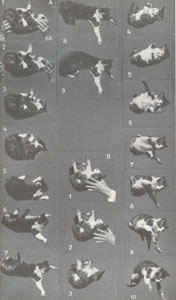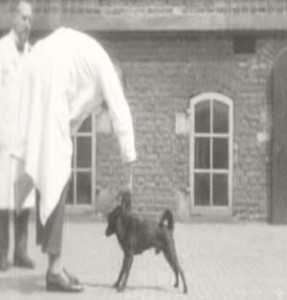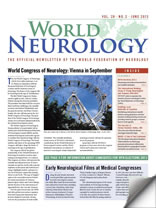During the past decade, historical neurological films gained popularity in the neurological community. Early films were made by neuroscientists in several cities, including Leuven (Van Gehuchten), Paris (Paul Sainton), Berlin (Paul Schuster and Arthur Simons), Bucharest (Georges Marinesco), Philadelphia (Theodore Weisenburg), Boston (Denny-Brown), Turin (Camillo Negro), Bologna (Vincenzo Neri), London (S.A. Kinnier Wilson), Utrecht (Magnus) and Leiden (Rademaker); many surfaced during the past decades.
The educational program of the American Academy of Neurology meetings included a session on archival neurological films for years. In fact, the use of cinematography for medical purposes started soon after the Lumiè
re brothers demonstrated their first film for paying audience in 1895, the same year that Wilhelm Conrad Röntgen discovered X-rays. However, it also was accompanied by a scandal, when films made by the Paris surgeon Eugè
ne Louis Doyen were illegally sold by his cameramen and shown at fairs and coffee houses. Not everyone realizes that neurology took interest in photography and photochronography for recording gait and movement disorders before the early days of cinematography. Working at the Salpàªtriè
re in Paris, Charcot’s photographer Albert Londe experimented with a 12-lens camera for this purpose. (See Figure 1.)

Figure 1. Albert Londe at the Salpàªtriè
re. The sitting person is physiologist Etienne-Jules Marey (1830-1904), a pioneer in the development of motion picture. Source: Société Française de Photographie, Paris
Neurological films were used for educational as well as scientific purposes. Scientists wished to show and prove their results at medical and physiological congresses, even though Doyen’s films were excluded during early French meetings (but demonstrated for the British Medical Association in Edinburg, including a film on craniotomy).
One of the persons who used cinematography for that purpose was Rudolf Magnus (1873-1927). Of German descent, he became professor of pharmacology (including physiology) at Utrecht (Netherlands) in 1908. Following a visit to Sherrington in Liverpool, he continued working on attitudinal reflexes, results of which he published in his Körperstellung (1924; “Body Posture”). He was nominated for a Nobel Prize, but died unexpectedly in 1927.
In the prestigious Croonian Lecture of 1925 (London), he said: “Many masterpieces of painting or sculpture representing human beings are consistent with the laws of attitudinal reflexes. But under pathological conditions … they are released, and are now used frequently by neurologists for diagnostic purposes.” In cooperation with De Kleyn, he found that tonic labyrinth reflexes should be distinguished from tonic neck reflexes, and with Rademaker, he discovered that the cerebellum does not play a role in body posture. (See Figure 2.)

Figure 3. From Magnus’ Körperstellung, turning in free fall; the reaction follows with extraordinary rapidity and security.

Figure 2. Still from a film showing young Rademaker and his teacher Magnus in Utrecht (early 1920s). Source: Institute of Sound & Vision, Hilversum, Netherlands.
Among the first congresses where cinematography was used was the Eighth International Congress of Physiology in Vienna (1910). Comments on the congress can be found in the diaries of Magnus. He was not only a great physiologist but also an average attendee, writing that he drank a beer after the opening dinner with the English delegates including Sherrington, whom he admired and who had recently published the famous Integrative Action of the Nervous System (1906). Magnus reported about interesting lectures he attended and was stressed about his own lecture the following day. The official report of the congress describes remarkable technical aspects, including the fact that lecturers were using cinematography more frequently. Magnus’ lecture on movement control by the central nervous system was mentioned as an example. Apparently, his film was so interesting that he was asked to show it twice, and in his diary, we read that the cinematographical projection went well and that the attendees were satisfied. In 1913, the Congress of Physiology was organized in Groningen (Netherlands). The official report mentions the highlights including a lecture by Ivan Pavlov, but also Magnus and his use of cinematography to demonstrate his work on body postures. The use of cinematography had increased at this congress and now included microscopic images and slow-motion films.
What about the first International Congress of Neurology in Bern (Switzerland, 1931)? Looking at the names in the Proceedings, it is obvious that many well known neurologists, some of whose names became eponyms, attended the congress and indeed several films were shown.
Otto Marburg of Vienna demonstrated a case of Wilson’s disease and a case of hydrocephalus, diagnosed by ventriculography and improving following treatment by X-rays. Kinnier Wilson himself was also present and lectured about disorders of tone. In a session on investigative neurology, chaired by the Portuguese neurologist Egas Moniz, physiologist Walter Rudolf Hess of Zürich showed a film on localized stimulation of the brainstem, caudate nucleus, thalamus and hypothalamus. In a session on clinical and biological issues, the Swiss surgeon Fritz de Quervain (of Bern) showed a film on movement disorders of the lower limbs. The length of the films was indicated in meters, not in minutes. Neurologists were not only early using photography but also cinematography.
Further Reading
Aubert G. From photography to cinematography: recording movement and gait in a neurological context J Hist Neurosci 2002;11:255-64.
Koehler is a neurologist in the department of neurology at the Atrium Medical Centre, Heerlen, the Netherlands. He serves as senior co-editor of the J Hist Neurosci. Visit his website at www.neurohistory.nl.
